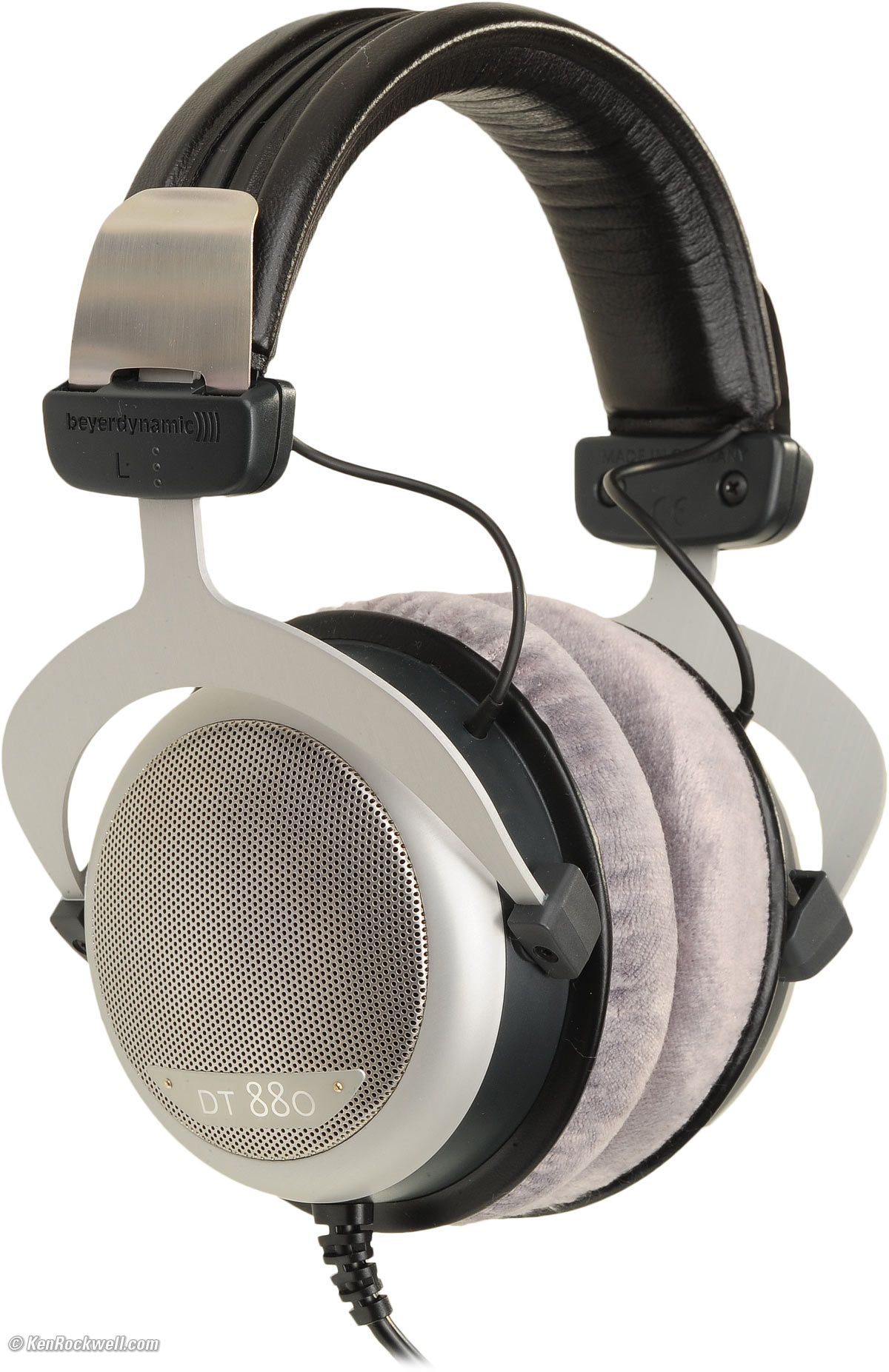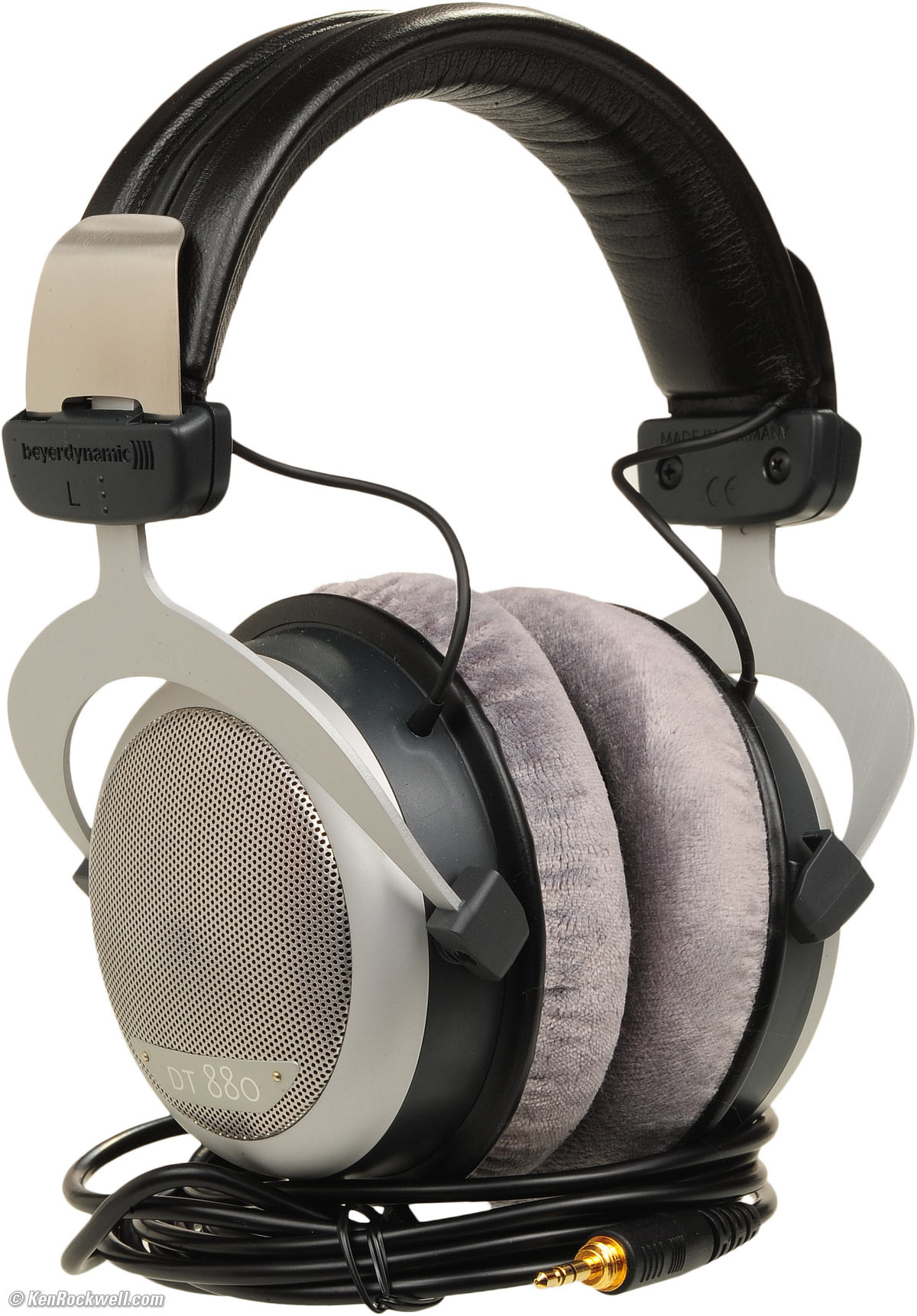Home Donate New Search Gallery Reviews How-To Books Links Workshops About Contact
beyerdynamic DT 880
MADE IN GERMANY
beyerdynamic DT 880 (10.4 oz./296g without cord, about $170). larger.
This all-content, junk-free website's biggest source of support is when you use those or any of these links to approved sources when you get anything, regardless of the country in which you live. Thanks for helping me help you! Ken.
May 2018 beyerdynamic Reviews Headphone Reviews Audio Reviews All Reviews
Newer, better and more expensive: beyerdynamioc Amiron Home. May 2018
|
|
The beyerdynamic DT 880 are first-class open dynamic headphones, and sell at a bargain price. They come in many different versions at different prices, and all sound the same.
It is a favorite among professional recording engineers for its accuracy, and a favorite among music lovers for its clean, open, uncolored and faithful-to-the-concert-hall sound. I greatly prefer this beyerdynamic DT 880 to the far more expensive Sennheiser HD 800.
I'd be happy with these as my only sound reproducer for the rest of my life. They sound much better than Ultrasone Edition 8 and Sennheiser HD800. The Stax are better and in a class by themselves, but require special power supplies. The DT 880 have no rough edges sonically or mechanically.
beyerdynamic calls the DT 880 a "semi-open" headphone, but they're lying. The DT 880 is an open headphone, with no isolation except at the very highest frequencies exactly like the beyerdynamic DT 990. The DT 990 is the same thing, just with boosted bass and treble compared to the DT 880. Likewise, as an open headphone, there is sound leakage so your neighbors will hear them, too.
These are tough, well-built, inexpensive and great sounding fully professional headphones from the world's leading maker of professional headphones. beyerdynamic has been making professional audio equipment since 1924 and the world's first professional headphones since 1937! If you want natural, open and uncolored sound from a tough set of professional headphones, get a pair for yourself.
The beyerdynamic DT 880 comes in at least three different versions with different impedances: 32Ω, 250Ω, and 600Ω.
The sound is identical among the different versions except for how loud they go. I've compared the 32Ω and 600Ω versions directly to each other on my Apogee Duet 2, iPod Touch and Benchmark DAC1 HDR. The only difference is sensitivity, and how much (inaudible) distortion I measure in the amplifier.
The important part is having enough sensitivity to play loud enough from portable devices (the 32 Ω version), and to a smaller extent, the potential for minimizing amplifier distortion if you have more than enough output from studio equipment (the 600 Ω version).
Don't sweat it: get the 32 Ω version for an iPod or iPad, the 600 Ω version for use at home or studio, or the usual 250 Ω version if you want it to do everything.
Personally, I bought the 600 Ω version and it works great even in my iPod, just not very loud, and of course is fantastic with my studio gear.

beyerdynamic's Impedance Suggestions.
The 32 Ω version will play louder from your iPod, while the 250 Ω and 600 Ω versions will require higher volume settings for the same level — or a dedicated headphone amplifier.
The 32 Ω DT 880 is about 5-10dB more sensitive from a constant voltage (as are most amplifiers) than the 600 Ω version. The 32 Ω version isn't as sensitive as the Ultrasone Edition 8, but it's close. FOr portable use, the long straight cord of the 32 Ω (or any of the) versions is a pain.
The 32 Ω version is the most sensitive, however with the lowest impedance, will be more likely to excite slightly more measured distortion.
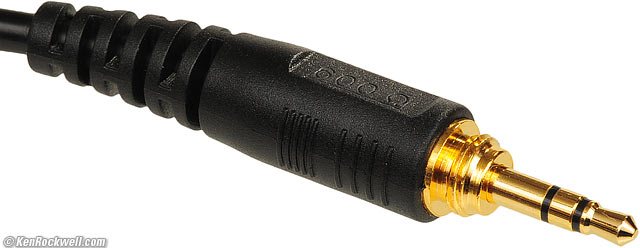
beyerdynamic DT 880 plug. Note molded "600 Ω" marking.
The higher-impedance versions are suggested for use in more critical applications because they are less likely to increase measured distortion or frequency response variations from most equipment. The higher impedance versions are suggested not because they perform any differently than the lower impedance versions, they are suggested because it's more likely that your other equipment will perform better with higher-impedance loads. The Germans think of everything.
You can use the 32Ω version with high-performance equipment; its sound is the same, and if you have a great headphone amplifier like the Benchmark DAC1 HDR, its performance won't be degraded by the lower impedance. However, most headphone amplifiers perform better with higher impedance headphones, and that is why beyerdynamic suggests them.
Higher impedance headphones will also have less distortion with portable equipment, however portable equipment usually doesn't have enough output voltage to drive higher impedance headphones as loud as many people want them to go. Therefore, for portable devices, the more sensitive 32Ω version will play louder, and most portable equipment is designed to work well with low-impedance headphones. In this case, the slight potential increase in amplifier distortion is outweighed by being able to play the headphones loudly enough in the first place.
beyerdynamic doesn't recommend the 600 Ω version for use with iPods, but it works great, just not very loud. I own the 600 Ω version, and with popular music I usually have my iPod set at close to its maximum volume, and with classical music and movies, I almost always have my iPod set to maximum, and wish I had another 5 to 10 more dB of gain. It sounds great, but I just can't make myself deaf.
Classical music and movies are recorded at lower average levels because they get very loud as well as soft, so playback level settings need to be higher for accurate reproduction — and allow much higher peak reproduced sound levels. In an idiotic attempt to make every CD sound as bad and loud as the next, most other music today is severely dynamically compressed and limited to be at 100% loudness all the time, so playback levels must be set much lower, eliminating musical peaks and dynamics, and half of the music with it.
Measured Impedance, 600 Ω version
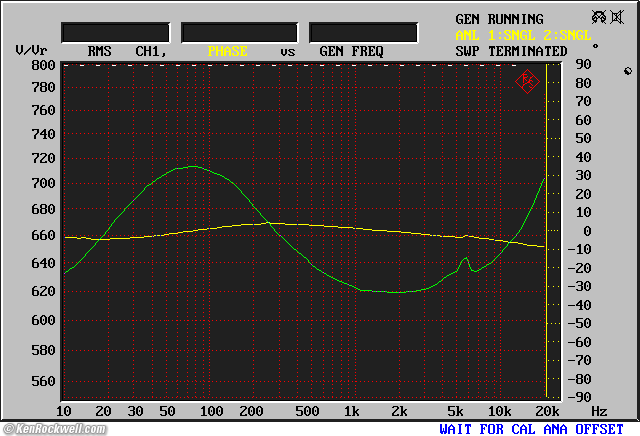
600 Ω beyerdynamic DT 880 measured Impedance magnitude (Ω), and phase angle versus frequency. (R&S UPL; +90º is capacitive, -90º is inductive.)
Measured Impedance, 32 Ω version
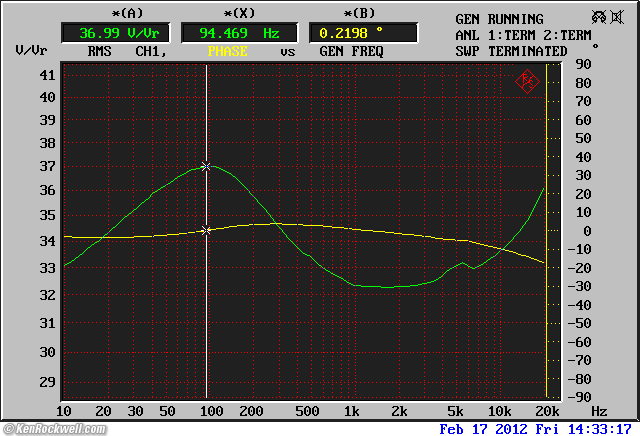
32 Ω beyerdynamic DT 880 measured Impedance magnitude (Ω), and phase angle versus frequency. (R&S UPL; +90º is capacitive, -90º is inductive.)
These curves look the same, the only thing different is the 600 Ω or 32 Ω version and the vertical scale. It's safe to say it's they are the same headphone, just a different impedance.
Amplification
The actual impedance of the 600 Ω version is about 660 Ω, but more importantly, it's almost purely resistive. These are trivially easy to drive so long as you have enough voltage from any real headphone amp.
Beware of the many expensive but wimpy headphone amplifiers with no more than 2 V RMS output, which isn't much more than the 1 V RMS output of an iPod. These wimpy amps are the ones often powered by batteries and sold with exotic DACs at high prices for use with iPods, but read the specifications carefully to be sure that they have plenty of output. Ask an electronic engineer if you need help.
A proper headphone amp should be able drive these to about 7 V RMS or 20 dBm or 100 mW into 600 Ω, which is more than deafening.
I auditioned these with various amplifiers, and the sound didn't vary — just the maximum output, which of course will vary the perceived bass response.
Sound
The DT 880 sounds awesome right out of the box without any break-in.
While the DT 880 has a little thinner tonal balance than the Stax SR-007 MK2 Omega II (a $3,000 electrostatic headphone), the DT 880 sounds pretty darn close. Worn for extended periods, I tend to forget which one I'm wearing. The DT880s have no response peaks or valleys to call attention to themselves, so the slight and broad balance differences are quickly forgotten. The sound of the DT 880 doesn't change much as I put my hands up to their outsides.
The DT 880s offer beautiful electrostatic sound, and they don't go Pop! when pressed to your head or demand a plug-in-the-wall bias source to drive them.
It's funny that the original 1988 beyerdynamic DT990 copied the appearance of the then state-of-the-art Stax Lambda, and these DT 880 today vaguely copy the appearance of today's state-of-the-art Stax Omega.
The DT880 is clean, clear and open like the Omegas, and doesn't feel that much different on the head. The DT 880 sounds light and airy, spacious, smooth, beautiful, clean and open. WIth the DT 880, you'll hear everything right — and wrong — with your recordings.
With the DT880 you're almost at the performance, while with the Omegas, you are there. For one-tenth the price of the Omegas, these DT880s are 95% as good.
The DT 880's soundstage is the same as most headphones. Only the Ultrasone Edition 8 do much of anything different.
The DT 880's neutral spectral balance is from the professional monitoring market, and less like boosted home hi-fi headphones. The DT 880s are dry and neutral, not warm unless something was recorded that way.
The overall spectral balance of the DT 880 has a little less bass and a little more midrange and lower treble than the reference Stax SR-007 MK2 Omega II, but the soundstage, depth, clarity and openness are about the same. Since the spectral differences are all very broad and devoid of peaks, listening for extended periods our ears compensate, and the DT 880 sounds absolutely awesome.
With the DT 880, you'll hear everything, including conductors singing along, breathing, page turns and seat creaks. It's easy to hear the difference between condenser and ribbon mics on vocals.
The beyerdynamic DT 880 has natural, unhyped, smooth and unboosted bass and treble. Casual users may prefer the beyerdynamic DT 990 or DT770, each of which have boosted bass and treble. The careful listener will prefer this DT 880 because it sounds right, while the boosts in the DT 990 and DT770 aren't exactly pretty. The treble boosts in the DT 990 and DT770 are peaky, and the bass of the DT 990 is somewhat boomy to the careful ear, with a broad peak around 60 Hz. The DT 880's bass sounds thinner at first because it isn't boosted, but after listening for a while, one realizes that the DT 880 reproduces all the bass, especially the deepest bass at 30 Hz and below, while the bass boost bump of the DT 990 hides the lowest bass underneath it. The bass from the DT770 is a bit stronger, and less boomy, but the DT770's treble is unpleasantly peaky.
The original 1988 DT990 is much more muffled, but the old DT990 has sparklier (smoothly boosted) highs.
Once you get over the lack of boom and peaky bass overemphasis of lesser headphones, the beyerdynamic DT 880 astounds with solid, undistorted bass to well below 20 Hz. Its response is strong down to 30 Hz, and still audible at 14.5 Hz! Of course below 20 Hz "audible" is more the room noise modulating itself from intermodulation with the headphone's subsonic input, but that's the way it works in live sound, too. The DT 880's bass is clean and clear with no boom, so the deepest bass isn't hidden behind it. Even driven to deafening levels with a real headphone amplifier, I can't get sine waves to buzz, rattle or distort. Pedals sound natural.
Compared to the Ultrasone Edition 8, the DT 880 lacks bass for enjoying movies, but for music, these DT 880s have far cleaner and open sound. The Ultrasone Edition 8 sounds colored, especially in the treble, by comparison. The DT 880 are less loud with less bass and have no isolation compared to Ultrasone Edition 8, but they sound much better, cleaner and more open for serious music listening.
Ergonomics
The beyerdynamic DT 880 are a very well made, no-surprises traditional headphone.
The earpieces tend to keep moving up into the harp by themselves when put away.
The earpads are semi-soft and covered with fuzzy velour.
The pads ride around your ears, not touching them.
They stick well on my head as I move around.
The padded harp cover seems like plastic fake leather over padding.
The DT 880 are comfy and not stuffy when worn all day.
The DT 880 use moderate to low spring pressure.
They have a long straight cord. I left most of it still coiled up, a trip hazard otherwise.
The DT 880 is made of almost all metal, and real metal, no pot metal like much of the Sennheiser HD800.
THis DT 880 is much sturdier than Sennheiser HD800. The DT 880 is tough enough for professional abuse.
The DT 880's pointy 3.5mm plug pops right into a cased iPad 2.
Specifications top
Type
Dynamic stereo headphones
Open-back, no isolation.
Circumaural: sits around the ear on your head.
Cable
beyerdynamic DT 880 with cord. enlarge.
2.5 meter (8 feet), straight.
3.5mm plug.
Screw-in ¼" adapter included for use with real equipment.
Frequency Response
5 ~ 35,000 Hz, no conditions specified, making these numbers a meaningless waste of ink.
Impedance
Rated 32 Ω, 250 Ω or 600 Ω.
Sensitivity
96 dB, no conditions specified.
Formal power sensitivity is the same for all impedances. The reason lower-impedance versions go louder at a given volume setting is because lower-impedance headphones draw more power at the same voltage output, and most devices put out the same voltage even with different loads.
It probably refers to the SPL with 1 milliwatt of input. If so, at 1 volt, this would be 111 dB for the 32 Ω version, 102 dB for the 250 Ω version and 98 dB for the 600 Ω version. 1 mW is 179 mV at 32 Ω, 500 mV at 250 Ω and 775 mV at 600 Ω.
Power Handling
100 mW, no conditions specified.
Free included case. enlarge.
Well-padded case included, claimed to be leather.
Weight
10.4 oz. (296g), actual measured, without cord.
12.675 oz. (359.3g), actual measured, with cord and ¼" adapter
10.2 oz. (290g), specified, without cord.
Included
DT 880 headphones.
Gold screw-in ¼" adapter.
Zippered case with foam insert. Claimed to be leather.
No instructions and no warnings, thank goodness. It just comes with a flyer talking about beyerdynamic's history.
Price, USA
$200, March 2018.
$170, March 2020.
More Information
beyerdynamic's page for the 250 Ω DT880.
© Ken Rockwell. All rights reserved. Tous droits réservés. Alle Rechte vorbehalten.
Help Me Help You
I support my growing family through this website, as crazy as it might seem.
The biggest help is when you use any of these links when you get anything. It costs you nothing, and is this site's, and thus my family's, biggest source of support. These places always have the best prices and service, which is why I've used them since before this website existed. I recommend them all personally.
If you find this page as helpful as a book you might have had to buy or a workshop you may have had to take, feel free to help me continue helping everyone.
If you've gotten your gear through one of my links or helped otherwise, you're family. It's great people like you who allow me to keep adding to this site full-time. Thanks!
If you haven't helped yet, please do, and consider helping me with a gift of $5.00.
As this page is copyrighted and formally registered, it is unlawful to make copies, especially in the form of printouts for personal use. If you wish to make a printout for personal use, you are granted one-time permission only if you PayPal me $5.00 per printout or part thereof. Thank you!
Thanks for reading!
Mr. & Mrs. Ken Rockwell, Ryan and Katie.
